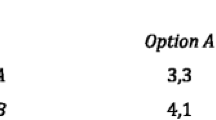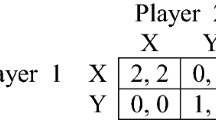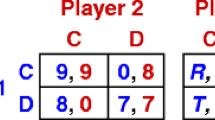Abstract
The aim of this paper is to study the role of the “common reason to believe” (Sugden in Philos Explor 16:165–181, 2003) and the reduction of social distance within the theory of team reasoning. The analysis draws on data collected through a Traveler’s Dilemma experiment. To study the role of the common reason to believe, players’ beliefs in their counterparts’ choices are elicited, and the correlation between the endorsement of team reasoning and beliefs is considered. The relation between social distance and team reasoning is analyzed by introducing a meeting between the two players after the game. We show that the common reason to believe appropriately explains the internal logic of team reasoning and that a reduction of social distance does not produce any statistically significant effect on the probability that team reasoning will be used.
Similar content being viewed by others
Notes
We cannot exclude that other reasons, such as the fear of being sanctioned by the counterpart, other than the adoption of team reasoning, may explain the emergence of this subjects’ behavior when a meeting after the game is introduced. We discuss this possibility in Sect. 5.
A footnote specifies that “team reasoning, narrowly defined” means “a mode of reasoning, followed by one individual, which prescribes that he should perform his part of whichever profile is best for the team” (Sugden 2003, p. 168).
The external problem concerns the question: “Should I endorse this mode of reasoning?” That is, even if I am sure that other members of the group will use team reasoning, should I do the same?
This hypothesis is compatible with Ellingsen et al. (2012) interpretation of team reasoning “as an internalized social norm that requires players to unconditionally pick the strategy profile that is consistent with joint payoff maximization” (p. 120). The reference is to Bacharach’s idea of unconditional adoption of team reasoning but, as the authors acknowledge, can be easily extended to Sudgen’s hypothesis of the conditional nature of team reasoning.
The instructions for the experiment are available from the authors upon request.
We believe that in this context, a prize given exclusively for a correct guess might be considered to be too difficult to win, thereby increasing the likelihood of casual answers. At the same time, procedures to elicit beliefs based on quadratic scoring rules (Davis and Holt 1993) are useless for a game—like our version of the Traveler’s Dilemma—which is characterized by a wide range of possible strategies. The use of tolerance thresholds for subjects’ guesses is used in the literature as a valid method for elicitation of beliefs (see, for example, Charness and Dufwenberg 2006; Croson 2000).
Subjects were recruited by e-mail from students on the mailing list of the two laboratories. Fourteen days before the experiment, they received an e-mail with an invitation to visit the Laboratory website for information about the experiment and subscriptions.
An individually self-interested player with a belief different from \( \underline{B} \) would maximize his/her payoff by choosing C i = B i(j) − 1. However, the decision to choose C i < B i(j) − 1 also reveals a clear intention to obtain the reward by undercutting the counterpart’s choice. Indeed, we classify all subjects who choose C i < B i(j) as individually self-interested players. This also takes into account that almost all the players in our experiment (and in the Traveler’s Dilemma game in general, according to the existing literature: Sect. 3.1) did not behave in the way standard game theory would predict that perfectly rational players would behave (choosing \( \underline{C} \) with a belief equal to \( \underline{B} \)).
Even though we find a high percentage of subjects who would be ready to pay the penalty (subjects who choose a number higher than their belief, see p. 19), this behavior is not adopted by subjects who implement team reasoning. Because of this, we can be confident that the C i > B i(j) behavior is not salient for these subjects or that it is less salient than the idea of team reasoning that they are actually implementing.
In the Traveler’s Dilemma, a player who endorses team reasoning and has a belief B i(j) ≠ \( \overline{B} \) will maximize the joint outcome by choosing C i = B i(j) ≠ \( \overline{B} \).
We also investigated the correlation between personal characteristics like age, gender, and income and the likelihood of the emergence of team reasoning, but we did not find any significant effect.
We focus on the VET treatment for a specific reason. Studies on relational goods highlight that even though relational goods may be created through encounters that take place in different environments, some circumstances seem more suitable than others. In particular, relations which are not constrained but which people voluntarily decide to commence are more effective for generating relational goods. For this reason, we may assume (as Becchetti et al. 2010 do) that players in the CET may think that the “forced” encounter after the game is not a good occasion for producing relational goods. Experimental results confirm this interpretation (see Becchetti et al. 2010).
According to our previous definitions, an individually self-oriented player chooses at least one unit below his/her “true” belief regarding his/her counterpart’s choice (C i < B i(j)), while a team reasoning player chooses a number equal to his/her “true” belief. In both these cases, players may decide to declare a belief lower than their choice so as to hedge against two possible risks. First, the risk that their counterpart undercuts their choice (in this case they would incur in the penalty). Second, but only with respect to the self-interested players, the risk that the counterpart chooses exactly the same number as they do, in this way not allowing them to obtain the prize. In the first case (undercutting situation) an hedging strategy (the more effective in case the player reasonable relies on his/her “true” belief) is to declare B i(j) = C i − 11. In the second case, an effective hedging strategy could be to declare a B i(j) = C i − 10. Our data reveal that no players follow the B i(j) = C i − 11 hedging strategy, while the behavior of 16 players (25.00 % of players who choose C i > B i(j)) is compatible with the B i(j) = C i − 10 strategy. We may not exclude that other strategies which result in a decision C i > B i(j) are motivated by less intuitive hedging strategy.
We would like to thank an anonymous referee for his/her suggestion regarding this possible interpretation.
This difference (30.00 % against 27.50 %) is less evident where strategic beliefs are considered.
Note that we do not find an effect of the different treatments on the number of subjects who behave like individually self-interested players (Table 4, columns 4 and 5): the effect of the compulsory meeting on the number of team reasoning players is mainly due to the reduction in the number of players who choose a number higher than their belief. In fact, the percentage of this kind of players is significantly lower in the compulsory meeting treatment (42.50 %) compared to the baseline (50.00 %).
Note that in performing these tests we compare only two treatments, the CET and the baseline. This significantly reduces our sample. We are not totally confident that the results would not change if there were a larger sample.
References
Ahmed A (2007) Group identity, social distance and intergroup bias. J Econ Psychol 28:324–337
Bacharach M (1997) “We” equilibria: a variable frame theory of cooperation. Institute of Economics and Statistics, University of Oxford, Oxford, p 30
Bacharach M (1999) Interactive team reasoning: a contribution to the theory of cooperation. Res Econ 53:30
Bacharach M, Gold N, Sugden R (eds) (2006) Beyond individual choice: teams and frames in game theory. Princeton University Press, Princeton
Basu K (1994) The Traveler’s Dilemma: paradoxes of rationality in game theory. Am Econ Rev 84(2):391–395
Becchetti L, Pelloni A, Rossetti F (2008) Relational goods, sociability, and happiness. Kyklos 61(3):343–363
Becchetti L, Degli Antoni G, Faillo M (2010) Let’s meet up! The role of relational goods in promoting cooperation. J Soc Econ 39:661–669
Bicchieri C (2006) The grammar of society: the nature and dynamics of social norms. Cambridge University Press, Cambridge
Blanco M, Engelmann D, Koch AK, Normann HT (2010) Belief elicitation in experiments: is there a hedging problem? Exp Econ 13:412–438
Bohnet I, Frey B (1999a) Social distance and other-regarding behavior in dictator games: comment. Am Econ Rev 89:335–339
Bohnet I, Frey B (1999b) The sound of silence in Prisoners Dilemma and dictator games. J Econ Behav Organ 38:47–57
Bruni L, Stanca L (2008) Watching alone: relational goods, television and happiness. J Econ Behav Organ 65(3):506–528
Capra MC, Goeree JK, Gomez R, Holt A (1999) Anomalous behavior in a Traveler’s Dilemma? Am Econ Rev Am Econ Assoc 89(3):678–690
Charness G, Dufwenberg M (2006) Promises and partnership. Econometrica 74(6):1579–1601
Charness G, Rabin M (2002) Understanding social preferences with simple tests. Q J Econ 117(3):817–869
Charness G, Haruvy E, Sonsino D (2007) Social distance and reciprocity: the internet vs. the laboratory. J Econ Behav Organ 63:88–103
Croson R (2000) Thinking like a game theorist: factors affecting the frequency of equilibrium play. J Econ Behav Organ 41(3):299–314
Davis DD, Holt CA (1993) Experimental economics. Princeton University Press, New Jersey
Degli Antoni G, Sacconi L (2011) Modeling cognitive social capital and corporate social responsibility as preconditions for sustainable networks of relations. In: Sacconi L, Degli Antoni G (eds) Social capital, corporate social responsibility, economic behavior and performance. Palgrave MacMillan, Basingstoke, pp 161–239
Ellingsen T, Johannesson M, Mollerstrom J, Munkhammar S (2012) Social framing effects: preferences or beliefs? Games Econ Behav 76:117–130
Fischbacher U, Gaechter S (2010) Social preferences, beliefs, and the dynamics of free riding in public goods experiments. Am Econ Rev 100(54):556–2010
Fischbacher U, Gaechter S, Fehr E (2001) Are people conditionally cooperative? Evidence from a public goods experiment. Econ Lett 71(3):397–404
Frey BS, Torgler B (2007) Tax morale and conditional cooperation. J Comp Econ 35(1):136–159
Frohlich N, Oppenheimer J (1998) Some consequences of e-mail vs. Face-to-face communication in experiment. J Econ Behav Organ 35:389–403
Gilbert M (1989) On social facts. Routledge, London
Goeree JK, Holt CA (2001) Ten little treasures of game theory and ten intuitive contradictions. Am Econ Rev 91(5):1402–1422
Gold N, Sugden R (2008) Theories of team agency. In: Di Fabienne P, Schmidt R (eds) Rationality and commitment. Oxford University Press, Oxford
Grimalda G, Sacconi L (2005) The constitution of the not-for-profit organisation: reciprocal conformity to morality. Const Polit Econ 16(3):249–276
Gui B (1987) Éléments pour une Definition d’Economie Communautaire. Notes et Documents de l’Institut International Jacques Maritain 19/20
Gui B (2000) Beyond transactions: on the interpersonal dimension of economic reality. Ann Public Cooper Econ 71(2):139–169
Gui B, Sugden R (2005) Why Interpersonal Relations Matter for Economics. In: Gui B, Sugden R (eds) Economics and social interactions, accounting for interpersonal relations. Cambridge University Press, Cambridge, MA, pp 1–22
Hodgson D (1967) Consequences of utilitarianism. Clarendon Press, Oxford
Hoffman E, McCabe K, Smith V (1996) Social distance and other-regarding behavior in dictator games. Am Econ Rev 86(3):653–660
Hollis M (1998) Trust within reason. University Press, Cambridge
Hurley S (1989) Natural reasons. Oxford University Press, Oxford
Isaac RM, Walker J (1991) Costly communication: an experiment in a nested public goods problem. In: Palfrey (ed) Laboratory research in political economy. University of Michigan Press, Ann Arbor, MI
Kramer R, Brewer M (1984) Effects of group identity on resource use in a simulated commons dilemma. J Pers Soc Psychol 46(5):1044–1057
Prouteau L, Wolff FC (2004) Relational goods and associational participation. Ann Public Cooper Econ 75(3):431–463
Rabin M (1993) Incorporating fairness into game theory and economics. Am Econ Rev 83(5):1281–1302
Rankin FW (2006) Requests and social distance in dictator games. J Econ Behav Organ 60:27–36
Regan D (1980) Utilitarianism and cooperation. Clarendon Press, Oxford
Roth AE (ed) (1995) The handbook of experimental economics. Princeton University Press, Princeton, pp 111–194
Rubinstein A (2007) Instinctive and cognitive reasoning: a study of response times. Econ J 117(523):1243–1259
Sacconi L, Faillo M (2010) Conformity, reciprocity and the sense of justice. How social contract-based preferences and beliefs explain norm compliance: the experimental evidence. Const Polit Econ 21(2):171–201
Scharlemann JPW, Eckel CC, Kacelnick A, Wilson RW (2001) The value of a smile: game theory with a human face. J Econ Psychol 22:617–640
Sugden R (1993) Thinking as a team: toward an explanation of nonselfish behavior. Soc Philos Policy 10:69–89
Sugden R (2000) Team preferences. Econ Philos 16:175–204
Sugden R (2003) The logic of team reasoning. Philos Explor 16:165–181
Tuomela R (1995) The importance of us. Stanford University Press, Stanford
Uhlaner CJ (1989) Relational goods and participation: incorporating sociability into a theory of rational action. Public Choice 62:253–285
Author information
Authors and Affiliations
Corresponding author
Appendices
Appendix 1: Timing of the experiment

Appendix 2
Figures 1, 2, and 3 show the relation between choice and belief across the different treatments. If we compare the single choice options, we note a concentration around the maximum choice (chosen by 11 people in the baseline, 12 people in the CET, and 12 in the VET). However, the wide majority of players pick a number higher than the Nash equilibrium solution (20) and lower than 200, with different combinations of choice and belief, with the majority of players choosing C i > B i(j) (around 45.00 %) and C i < B i(j) (around 37.00 %).
Rights and permissions
About this article
Cite this article
Becchetti, L., Degli Antoni, G. & Faillo, M. Team reasoning theory: an experimental analysis of common reason to believe and social distance. Int Rev Econ 60, 269–291 (2013). https://doi.org/10.1007/s12232-013-0182-4
Received:
Accepted:
Published:
Issue Date:
DOI: https://doi.org/10.1007/s12232-013-0182-4







